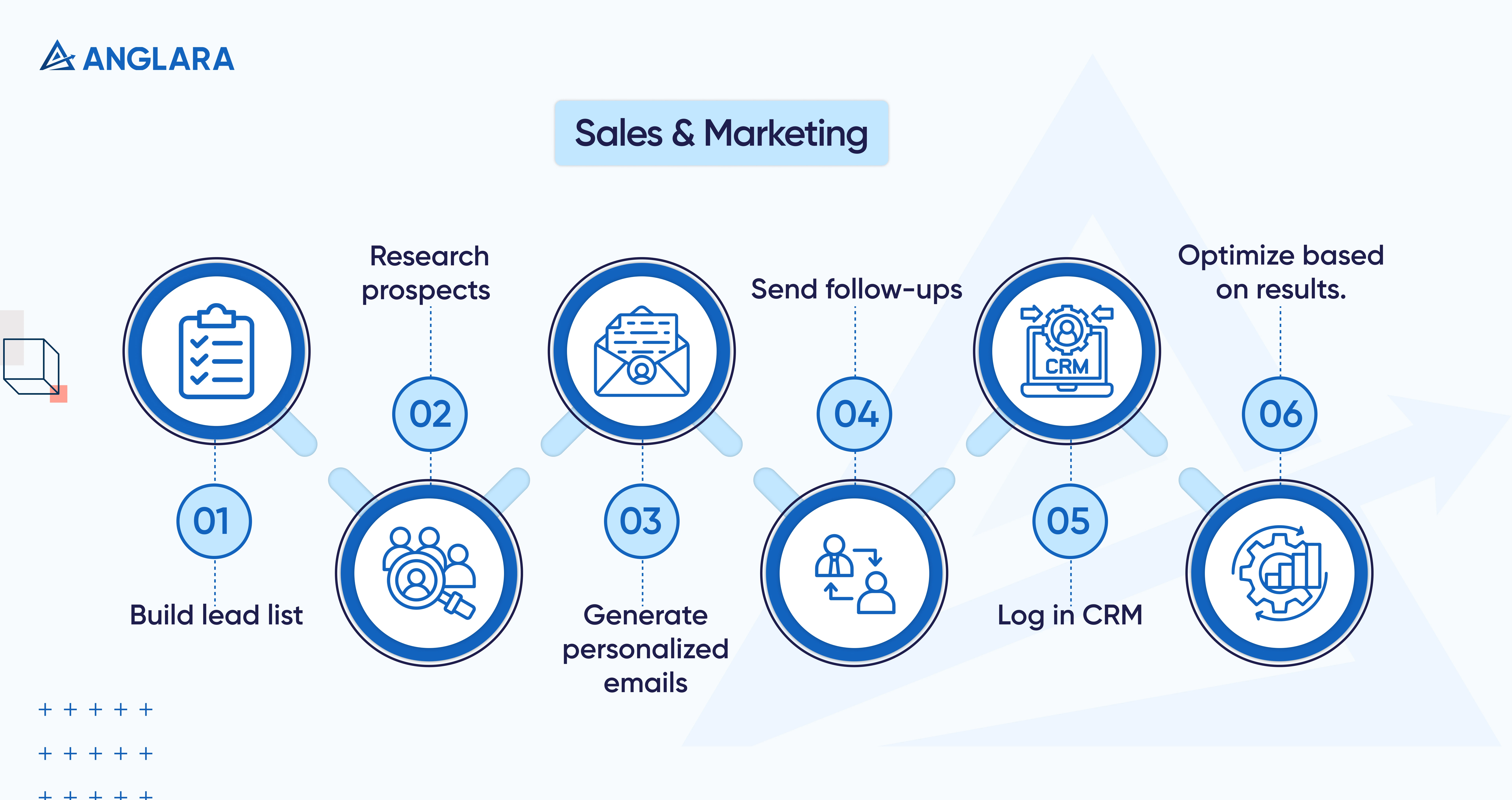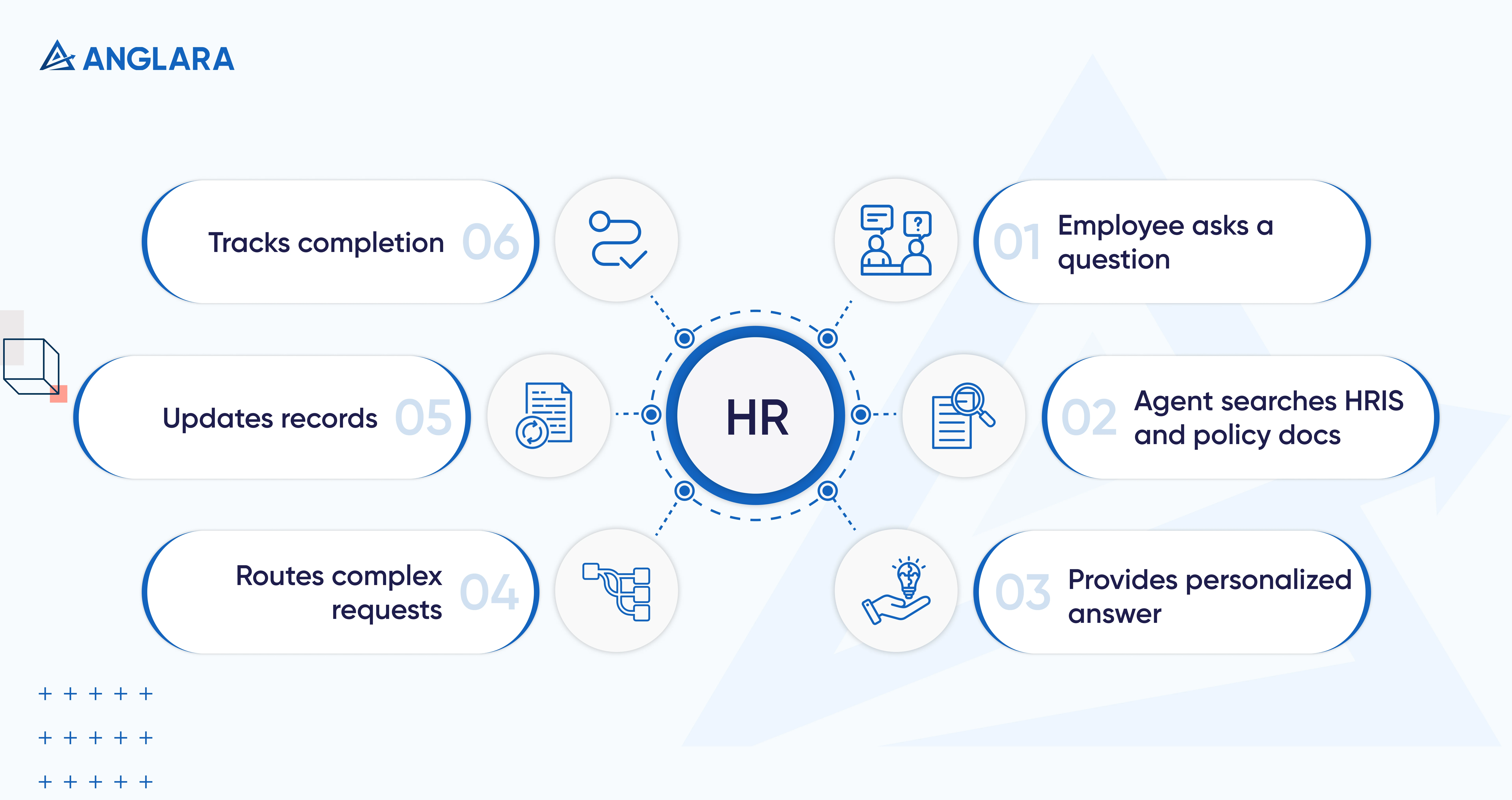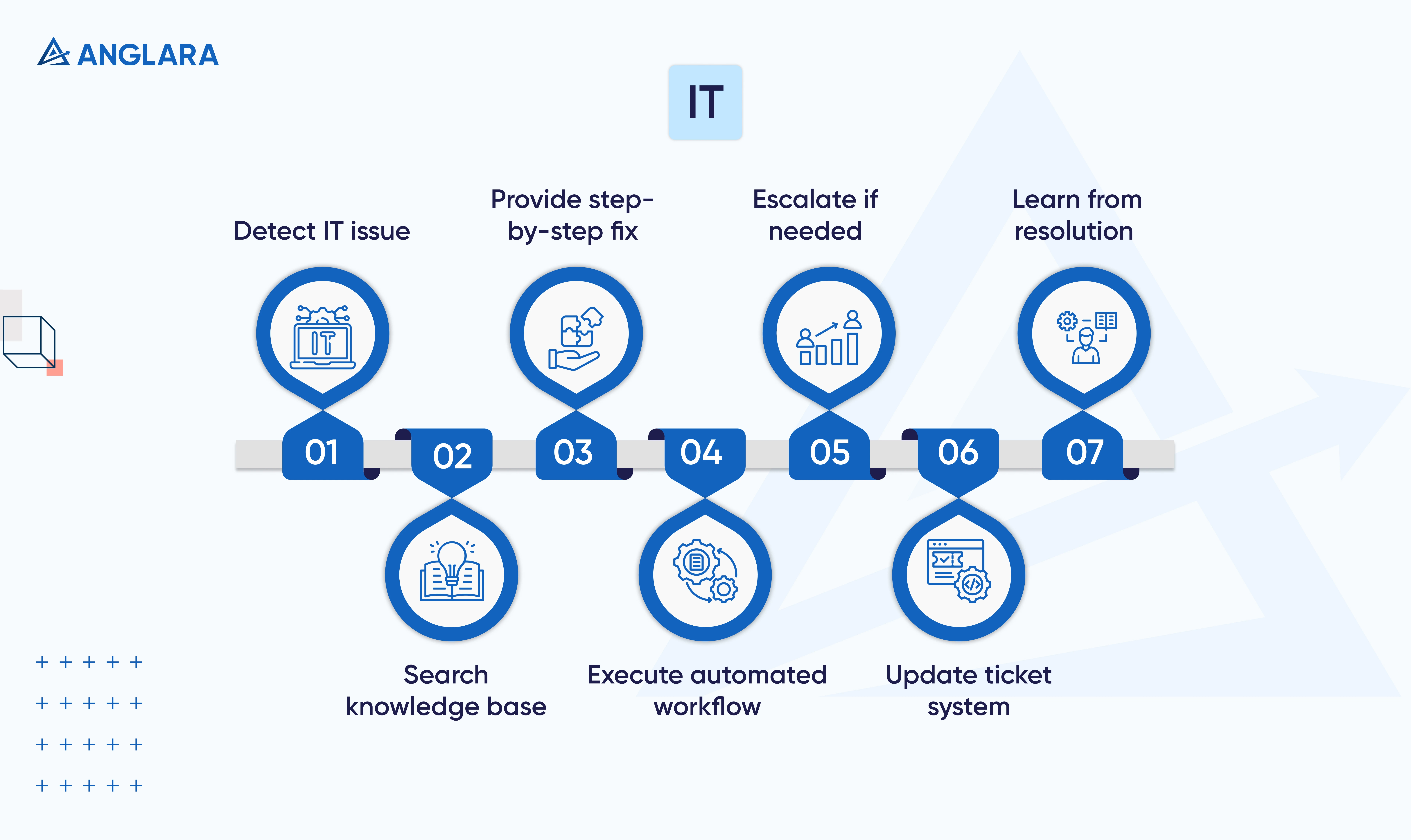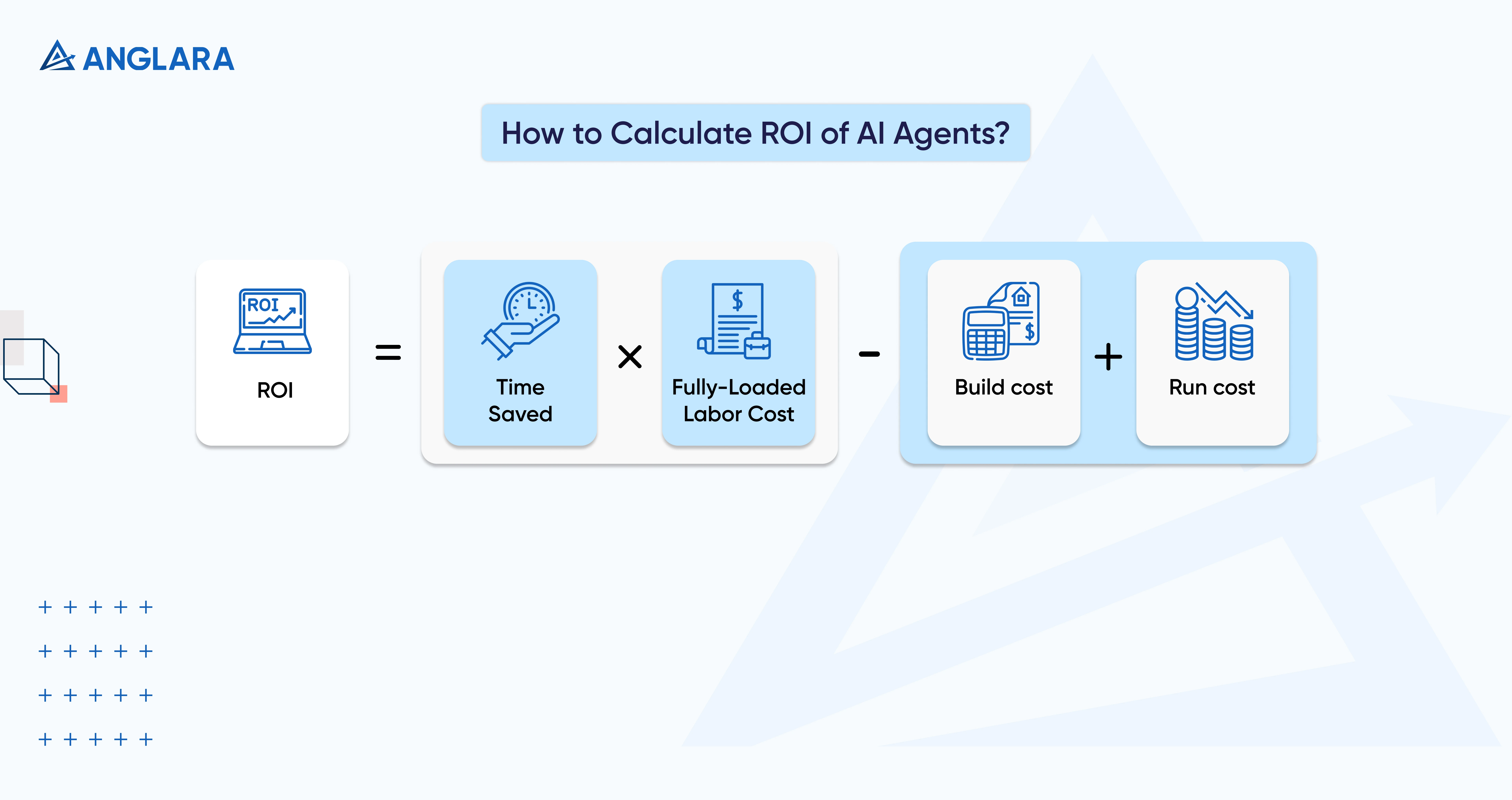In 2025, 78% of organizations use artificial intelligence (AI) in at least one business function, driving productivity and cutting costs. It can help drive strategy and innovation while handling repetitive tasks across various departments, including customer support, sales, marketing, and finance.
In this article, we break down real AI agent use cases and even explain the ROI math to calculate the returns it can deliver. Keep reading till the end to see how AI agents can power your business.
What are AI “Agents” vs Chatbots vs RPA?
AI agents use AI, including machine learning (ML) and large language models (LLM), to achieve specific goals by perceiving their environment and reasoning to take actions without human intervention.
An AI agent plans, acts, observes the results, and then reflects on those observations until the goal is achieved.
LLM chatbots and Robotic Process Automation (RPA) bots can’t act independently or possess learning and reasoning capabilities.
LLM chatbots use conversational AI, enabling them to respond to user-provided input (queries), whereas RPA bots simply automate repetitive, rule-based tasks by following deterministic scripts.
Here’s a table of differences between agents, chatbots, and RPA bots:
When to use (and not use) AI agents?
Habi, a group voice chat app, improved efficiency and cut costs by using AI to automate document management, enabling staff to focus on higher-value activities. Similarly, businesses can use AI agents to create routine tasks, allowing employees to concentrate on strategic work.
You may use AI agents to:
- Automate complex multi-step processes that span across CRM, ERP, and enterprise data platforms.
- Integrate with external APIs to fetch, process, and update data in real time.
- Operate autonomously, dynamically adjusting based on real-time feedback and changing conditions.
- Learn from outcomes to continuously refine strategies and improve performance.
Avoid AI agents when:
- Tasks are simple, single-step, or conversational — instead, use AI chatbots
- Highly repetitive, rule-based processes on legacy systems — instead use RPA bots
- Budget or timeline constraints exist, as AI will cost you before it pays you back. RPA or AI chatbots can be more cost-effective to implement.
What is the architecture of an AI Agent?
Imagine an AI agent’s architecture as a building with separate floors for sensing, thinking, remembering, and acting. Each floor works autonomously to complete tasks.
Here’s what makes up each floor of that building:
- Perception (LLMs): Understands human language and context
- Memory: Remembers past interactions for smarter decisions
- Tools (APIs): Connects to systems to perform tasks
- Policies/Guardrails: Ensures safe, ethical behavior
- Orchestration (Workflows): Plans and manages tasks step-by-step
- Observability (Monitoring): Tracks performance to improve over time
As AI becomes a catalyst for business, embedding safety and compliance into its architecture is crucial for enterprises to build trust, protect data integrity, and future-proof their AI systems.
69% of companies have already implemented responsible AI practices to manage compliance risks and protect data integrity.
The central principles of AI safety and compliance that must be considered while building AI agents are:
- PII Handling: To protect personal data by following strict rules like GDPR, using encryption, anonymization, and access limits to keep information safe.
- Role and Goal Constraints: AI follows a set of permissions that stop it from taking actions outside its purpose/authority. This helps prevent unauthorized or risky behavior.
- Tool Whitelists: AI can access and use only pre-approved systems/APIs, which helps prevent unintended, unsafe, or unauthorized actions.
- Rate Limits: Setting limits on how often an AI agent can send requests helps prevent system overload and maintain stable and reliable performance.
- Audit Logs: Every action and decision is recorded in detailed, unchangeable logs for compliance checks and accountability.
What are some AI agent use cases?
AI Agents are used to automate numerous tasks across departments and industries. Let’s now explore how businesses are using AI for different functions so that you can consider the use cases for your business.
Customer Service & CX
AI-powered auto-triage agents can automatically sort and prioritize customer-reported queries and concerns, instantly resolving simple issues and reducing response times. For example, a proactive “order issue” agent identifies problems early, enabling faster fixes, while AI agents provide 24/7 multilingual support for inclusive customer service.
Here’s how it works:

Moveworks’ off-the-shelf helpdesk agent has reduced resolution time by 45%. Think what a custom-made agent for your business can do. It not only boosts employee satisfaction but also alleviates the workload of your customer support staff.
Expected outcome of implementing AI agents for customer service: Reduced response time, higher CSAT, and lower cost per ticket.
KPIs to track:
- First-response time: MFI Medical, a medical supplier company based in California, used AI agents to address customer queries and reduce first response time by 87.5%
- Average handle time (AHT): Good Eggs, an online grocery delivery service, built an AI co-pilot to automate the resolution of common customer issues and cut AHT by ~40%
Sales & Marketing
AI-powered SDR agents automate the entire outreach process, from building lead lists to crafting personalized emails and logging every interaction in your CRM. These agents don't just send generic templates. They analyze LinkedIn posts, funding announcements, and company news to create hyper-relevant messages that actually get responses.
Here's how it works:

Companies using AI SDR agents report open rates of up to 68% and 5-7x reply rates, compared to > 5% with traditional cold outreach.
Expected outcome of implementing AI agents for sales and marketing: Higher conversion rates, reduced cost per lead, and more pipeline generated per rep.
KPIs to track:
- Reply rate: Top-performing AI SDR campaigns achieve 70% reply rates.
- Meeting conversion rate: AI-powered outreach converts 4-7X leads into booked meetings.
- Cost per lead: Organizations using AI-driven sales automation see 60-70% lower cost per qualified lead
Operations & Supply Chain
AI agents monitor inventory levels, reconcile purchase orders, and predict when you'll run out of stock before it happens. They analyze sales patterns, supplier lead times, and external factors like seasonality to optimize ordering. When discrepancies pop up between invoices and POs, these agents flag them instantly and route them for resolution.
Here's how it works:

Walmart uses AI agents to forecast demand and adjust inventory across its network, factoring in local events and weather patterns. DHL employs AI-powered agents to track shipments in real-time, identify potential delays, and suggest alternative routes to prevent disruptions.
Expected outcome of implementing AI agents for operations: reduction in manual reconciliation time, improvement in inventory accuracy, and increased ROI.
KPIs to track:
- Purchase order cycle time: AI-driven PO processing reduces cycle times by up to 80% while tightening audit trails
- Ticket deflection rate: AI agents deflect 40-60% of repetitive support tickets, freeing teams to handle complex issues
- Stockout reduction: AI inventory agents help reduce stockouts by optimizing reorder points and quantities based on real-time demand
Finance & Risk
AI agents in finance can extract data from invoices, match them to purchase orders and contracts, and flag any discrepancies before payments go out. They scan expense reports for policy violations, duplicate charges, and unusual spending patterns that humans might miss. When anomalies surface, the agent drafts an email requesting clarification and escalates only when necessary.
Here's how it works:

Anglara helped a multi-facility healthcare provider detect advanced threats early without slowing clinicians, using an AI-assisted security layer, AI Shield. It ingests telemetry from endpoints, firewalls, EHR access logs, and identity systems, then flags risky behavior in real time. Automated playbooks isolate compromised devices and revoke tokens within minutes. The system stopped an attack path that would have exposed critical systems and halted operations—averting losses estimated at up to £10M. Read the full case study
HR
AI agents handle everything from answering benefits questions to routing onboarding tasks and processing leave requests. They provide 24/7 support across time zones, pulling information from multiple HR systems to give employees accurate answers instantly. When a new hire joins, the agent guides them through paperwork, schedules training, and connects them with their team.
Here's how it works:

IBM WatsonX Assistant reduces the time employees spend on common HR tasks by 75%. Companies using AI-driven onboarding see 82% higher retention and complete the process faster.
Expected outcome of implementing AI agents for HR: faster onboarding, an increase in employee engagement, and cost savings per implementation.
KPIs to track:
- Time to onboard: AI-powered onboarding reduces completion time by 53%, getting new hires productive 40% sooner
- HR ticket volume: AI agents deflect 30-60% of Tier-1 HR requests, reducing case volume and freeing HR teams for strategic work
Employee satisfaction: Organizations using AI HR assistants report 30% higher employee satisfaction scores within six months
IT
AI-powered helpdesk agents resolve common IT issues, such as password resets, software access requests, and device provisioning, without human intervention. They triage tickets, route complex issues to the right specialists, and provide instant answers by searching across knowledge bases and past tickets. When employees need new software or hardware, the agent automatically handles approvals, provisioning, and setup.
Here's how it works:

Luminis Health implemented self-service AI and saw a 25% reduction in call volume just weeks after launch. An AI-powered IT service desk can reduce ticket resolution time by 50% and cut helpdesk inquiries by up to 30%.
Expected outcome of implementing AI agents for IT: Reduction in ticket resolution time, decrease in support costs, and an increase in Tier-1 tickets resolved automatically.
KPIs to track:
- First-response time: AI helpdesk agents provide instant responses to common IT requests, reducing first-response time from hours to seconds
- Ticket deflection rate: AI-powered self-service deflects 40-60% of IT tickets, allowing support teams to focus on critical infrastructure issues
- Resolution accuracy: AI systems maintain a solid accuracy on automated resolutions while continuously learning from new interactions
Sector-specific use cases
AI Agents are used to automate numerous tasks across departments and industries. Here are 36 industry-specific use cases, along with a quick AI workflow, to show how businesses are using AI across different functions.
Healthcare:
- Prior authorization prep & submission: AI retrieves EHR data, fills payer forms, submits requests, and tracks approvals.
- Revenue cycle follow-ups: AI checks eligibility, monitors claim status, and drafts insurance appeals.
- Patient access & scheduling: AI handles patient intake, verifies insurance, and books appointments.
- Discharge & care-plan adherence: AI sends follow-ups, medication reminders, and risk alerts after discharge.
- Clinical documentation scribe (HITL): AI drafts clinical notes for providers to review and approve.
- Quality & safety reporting: AI auto-generates incident reports from care logs and notes.
Legal:
- Contract review & clause extraction: AI scans agreements, flags risky terms, and suggests compliant edits.
- Client intake triage: AI collects client details, classifies matters, and automates case intake.
- E-discovery summarization: AI reviews case documents and generates concise issue summaries.
- Docket & deadline management: AI tracks court deadlines, sends reminders, and prepares filings.
- Compliance change monitoring: AI monitors regulations and updates internal policies accordingly.
- Time capture & billing QA: AI detects missing time entries and flags billing anomalies.
Finance:
- Invoice capture & coding: AI reads invoices, assigns GL codes, and routes them for payment.
- Expense policy audit: AI validates receipts, identifies violations, and automatically requests corrections.
- AR collections prioritization: AI ranks overdue accounts and schedules collection reminders.
- FP&A variance explainer: AI analyzes variances and generates plain-language summaries.
- Fraud alert triage: AI detects suspicious transactions and escalates verified risks.
- Vendor risk & due diligence: AI aggregates company data to produce quick risk reports.
Real Estate:
- Lead qualification & nurturing: AI enriches prospect data, scores intent, and automates follow-up.
- Property matchmaker: AI recommends properties that align with buyer needs and budgets.
- Offer/lease document prep: AI fills lease terms, checks clauses, and manages signature workflows.
- Maintenance coordination: AI categorizes requests, books contractors, and confirms completion.
- Tenant onboarding/offboarding: AI automates access setup and ensures proper handover.
- Market comp & rent review: AI gathers comparable listings and recommends rent adjustments.
Ecommerce:
- Customer support triage & resolution: AI categorizes issues and resolves common support requests.
- RMA/returns orchestration: AI generates return labels, tracks shipments, and updates customers.
- Catalog enrichment: AI standardizes titles, descriptions, and attributes across listings.
- Pricing & ads ops: AI automatically adjusts bids, monitors performance, and safeguards margins.
- Order-issue watchdog: AI detects delivery issues early and proactively alerts customers.
- Inventory reorder agent: AI forecasts demand and creates automatic replenishment orders.
Travel:
- Itinerary planning & rebooking: AI plans complete trips and handles rebooking's during disruptions.
- Disruption (IRROPS) handling: AI alerts travelers to changes and automates refunds or rebooking's.
- Fare & rate monitoring: AI tracks fares in real time and rebooks when cheaper options appear.
- Loyalty & upsell concierge: AI tailors upsell offers like upgrades, extras, and lounge access.
- Refunds/chargebacks automation: AI compiles transaction data and submits dispute claims.
- Supplier RFQ & contract assist: AI compares vendor offers and drafts optimal contract terms.
How to calculate ROI of AI agents?
It’d be improper to calculate AI ROI solely based on increased sales. One must also consider the savings from reduced task time and lower operational costs.
The easiest way to estimate ROI for AI agents is to use this formula:

AI agents deliver the quickest ROI by automating high-volume, repetitive tasks, such as customer support, accounts payable, and IT helpdesk operations. Their ability to significantly reduce task time and errors while cutting labor costs makes them especially valuable for mid-size to large enterprises.
Deciding whether to build your own AI agent, buy an off-the-shelf solution, or partner for your AI initiatives depends on how critical AI is to your business, your internal capabilities, and how quickly you want results.
Let’s look at the three options in detail:
Build your own AI agent
Building in-house gives you full control and deep customization for AI that’s core to your business; however, it demands significant upfront cost, rare AI talent, high infrastructure investment, and ongoing maintenance — resources many teams lack.
Complexity, long development cycles, and the risk of project delays mean this approach suits only organizations ready to commit heavily.
Who should build: Enterprises that rely heavily on proprietary data or that need strict compliance and custom AI development often choose this route.
Buy off-the-shelf
Buying off-the-shelf AI tools is the fastest way to get started. These solutions are plug-and-play, cost less initially, and often fit common use cases like chatbots, analytics, or document processing. But what you gain in speed, you lose in flexibility, as customization is limited, and vendor lock-in can be a long-term risk.
Who should buy: It’s a solid option if your AI needs are straightforward and you want measurable outcomes fast without major internal change.
Partner with an AI development agency
Partnering with an AI software development agency like Anglara combines the best of both worlds. You get speed and flexibility without having to build everything from scratch.
Anglara’s team brings domain expertise, advanced tools, and proven frameworks to deliver custom AI solutions that integrate seamlessly with your existing systems. This approach helps you scale faster, cut operational overhead, and still maintain ownership of your data and IP.
Who should partner: It’s ideal for teams that want tailored solutions, faster time-to-market, and guaranteed technical depth — without the cost or complexity of building an internal AI department.
Book a free 30-minute consultation with Anglara to scope your first production-grade agent and discover how to turn your AI vision into action.
Implementation playbook (90 Days)
Successfully launching AI agents requires a structured approach across. Here’s our structured 90-day plan that allows our clients to reduce risks, accelerate time-to-value, and build a strong foundation for scaling AI agents successfully:
Day 0–15: Discovery & Preparation
- Conduct a detailed discovery and data audit
- Define project guardrails and success metrics
Day 16–45: Pilot & Validation
- Run pilots in a sandbox environment
- Utilize human-in-the-loop QA for quality assurance
- Set up evaluation tools and measurement harness
Day 46–90: Deployment & Scaling
- Implement orchestration workflows with logging and alerts
- Establish rollback plans for risk mitigation
- Deliver training and document standard operating procedures (SOPs)
What are considerations for AI-related risks, controls, and governance?
AI agents present specific risks that require proactive controls to ensure safety and compliance. Common failure modes include:
- Hallucinations (False or Made-up Outputs): These occur when AI models generate confident but incorrect or fabricated information. Because AI predicts likely word patterns without true understanding, it can produce believable but false statements, fake references, or misleading data.
Repercussions:
- Misinforming users can lead to poor or dangerous decisions, especially in critical fields like healthcare, finance, and legal services, where errors can result in patient harm, financial loss, or legal penalties.
- Brand reputation suffers when AI outputs are found unreliable or misleading.
- Hidden costs rise since humans must continuously monitor, verify, and correct AI outputs, which can offset efficiency gains.
- Tool Abuse (Misuse of Connected Systems): AI systems integrated with other software or tools may be manipulated, either unintentionally or maliciously, to perform undesirable actions, such as unauthorized data access, excessive automation of sensitive commands, or amplification of errors.
Repercussions:
- Uncontrolled AI actions risk data breaches, compliance violations, or operational disruptions.
- Improperly managed AI tool use can magnify errors or malicious exploits, leading to financial and reputational damage.
- Feedback Loops (Repeated Errors Reinforcing): Feedback loops happen when AI systems learn from their own flawed outputs or user corrections that reflect misunderstandings, causing errors to propagate and worsen over time.
Repercussions:
- Error magnification reduces AI effectiveness and accuracy across deployments.
- User trust declines as AI produces increasingly inaccurate or nonsensical results.
- Recovery requires costly retraining, human intervention, or redesign.
These risks can lead to minor errors, financial losses, legal trouble, and damaged trust. To keep AI safe and reliable, companies need strong human oversight, clear rules, constant monitoring, and technical safeguards. This helps catch mistakes early, prevent misuse, and maintain control over AI actions.
Key controls to mitigate these risks include:
- Tool authentication to ensure proper user access
- Rate limits or caps to prevent abuse or overuse
- Continuous evaluation and testing to catch errors early
- Kill-switch mechanisms for emergency shutdowns
- Multi-level approvals for sensitive actions
Compliance with regulations such as GDPR, HIPAA, and PCI-DSS depends on the agent’s context and the data it handles. It’s critical to embed compliance checks and audit trails into governance.
Frequently asked questions
Are agents safe for regulated data?
Yes. AI agents built and integrated by Anglara follow strict controls, such as access management, encryption, and continuous monitoring, to protect sensitive data and ensure compliance with regulations such as GDPR, HIPAA, and PCI-DSS.
How do agents differ from copilots?
AI copilots help you complete tasks when you ask. AI agents can take action on their own. Copilots assist, agents act.
What’s the best first use case?
The best first use case for an AI agent is any high-volume, repetitive tasks, such as invoice processing or customer support triage, that deliver quick ROI and manageable complexity.
What metrics matter?
Some of the KPIs to track after implementing AI agents are time saved, error reduction, throughput increase, compliance adherence, and user satisfaction, to measure impact.





